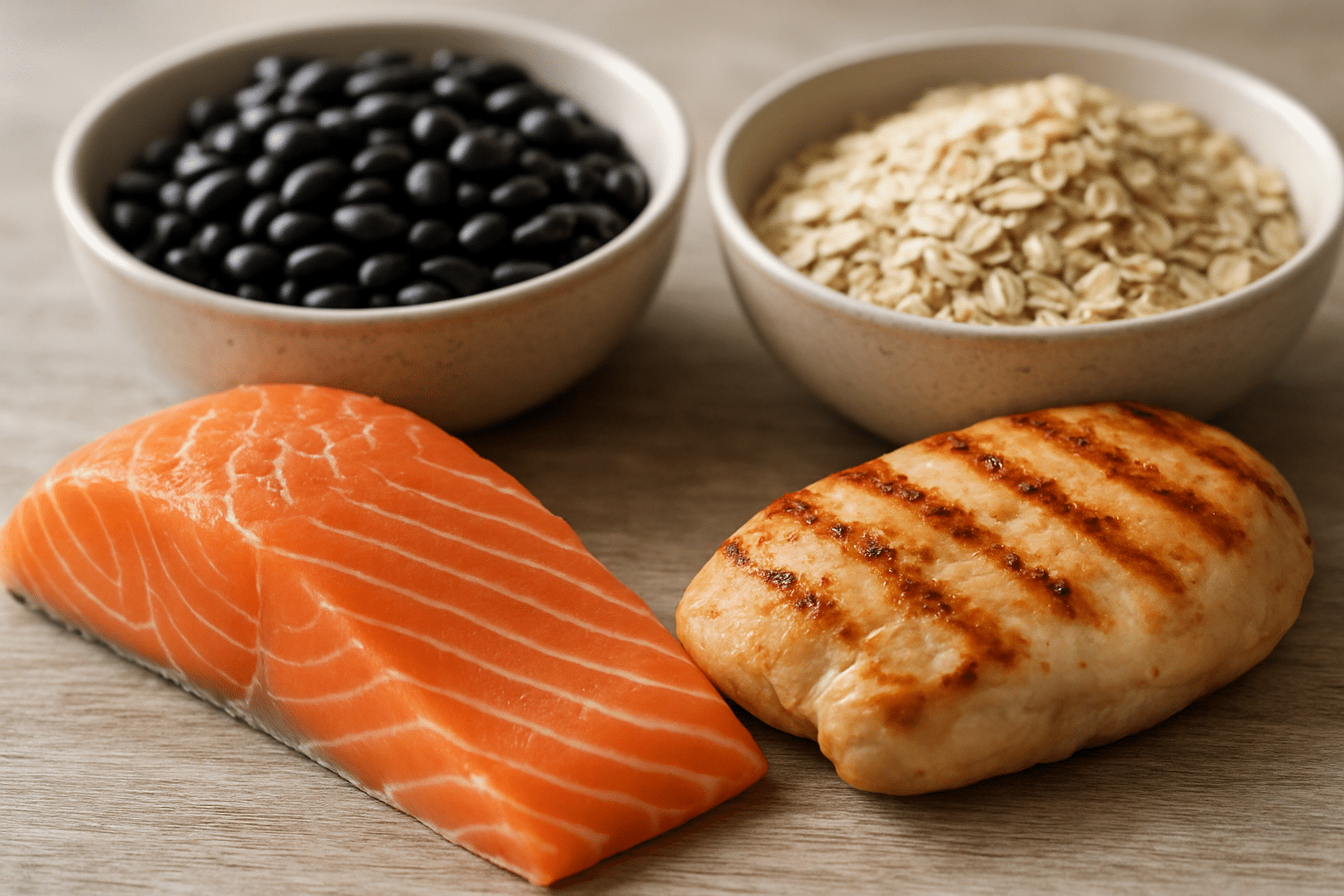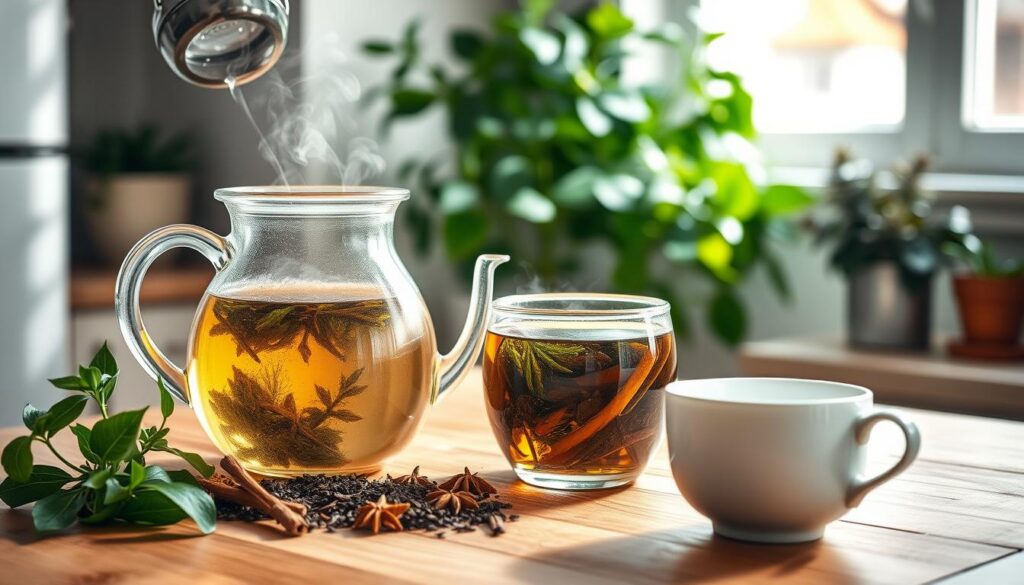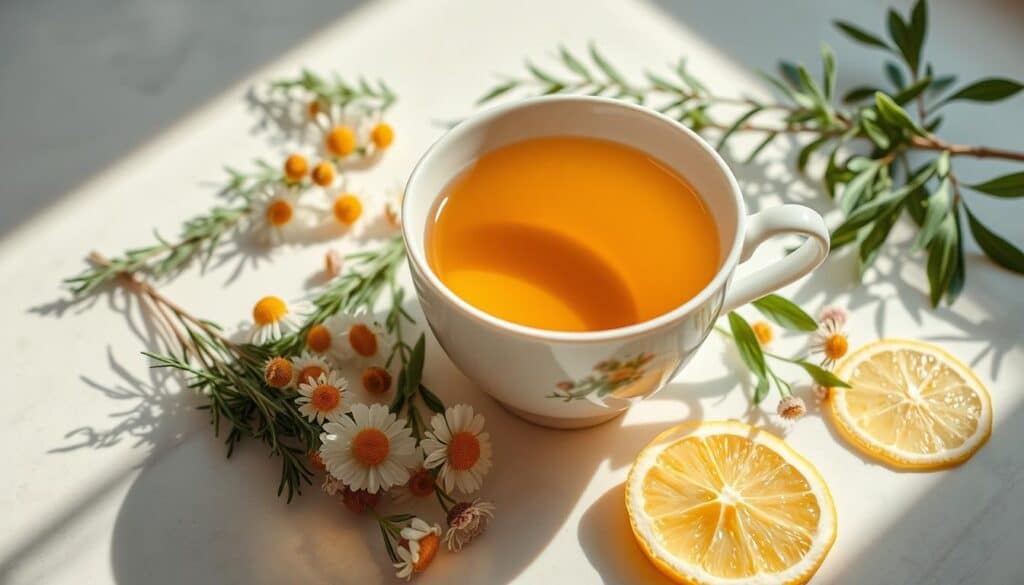Anúncios
Does your diet already include natural collagen sources?
Tea has been part of daily life in the United States and around the world for centuries. In this guide, we explore how regular drinking and topical use of natural teas can support skin health, boost radiance, and strengthen resilience. You’ll learn which brews help acne, hyperpigmentation, and aging, and why green tea for skin is often a top pick.
This article promises evidence-based guidance on the best teas for skin health, how they work, and practical steps to brew them for maximum benefit. Expect clear explanations of the main active compounds you’ll encounter—polyphenols like catechins and EGCG, flavonoids, curcuminoids, saponins, minerals, and volatile oils—and how each class supports the skin.

Natural Foods Rich in Collagen
The target audience is U.S. readers who favor natural beauty and want complementary approaches to skincare. The tone is friendly and practical, aimed at readers who want safe, usable advice rather than vague claims. We cover benefits, specific teas, acne-fighting options, brighteners, anti-aging choices, brewing and consumption guidance, safety notes, DIY blends, and how to integrate tea into a holistic routine.
Meta title: Radiant Skin Secrets: Natural Teas to Improve Skin. Meta description: Sip your way to a glowing complexion with our guide on natural teas to improve skin! Discover your path to radiant, healthy skin.
Key Takeaways
- Natural teas to improve skin work through antioxidants, anti-inflammatory agents, and nutrients.
- Green tea for skin provides EGCG, which helps protect collagen and reduce damage.
- Choose the best teas for skin health based on your concern—acne, dark spots, or aging.
- Simple brewing and timing boost benefits; some teas also complement topical care.
- Pay attention to safety, allergies, and interactions before adding new herbal blends.
Why Choose Natural Teas for Skin Health
Natural teas offer a simple way to support skin from the inside out. They supply botanical antioxidants for skin and deliver gentle compounds that help protect collagen and cell membranes. Drinking the right blends can complement topical sunscreens and serums to reduce cumulative oxidative stress.
Tea antioxidants EGCG from green tea and polyphenols in oolong act as scavengers of free radicals produced by UV exposure, pollution, and normal metabolism. These compounds protect cellular structures and may slow photoaging by limiting collagen degradation and MMP activation.
Regular intake of antioxidant-rich teas, paired with daily sun protection, can lower overall oxidative damage. Small, steady habits tend to show the best results over months rather than days.
How anti-inflammatory properties support complexion
Many herbal blends contain anti-inflammatory teas that calm irritated skin. Chamomile’s apigenin, turmeric’s curcumin, and rooibos’ aspalathin reduce cytokine-driven redness and swelling. These effects can ease inflammatory acne lesions and flare-ups of rosacea or eczema.
Benefits are usually modest and work best when combined with targeted topical care or medical treatment for moderate-to-severe conditions.
Hydration plus nutrients: a dual approach to glow
Hydration for skin glow starts with fluid balance. Unsweetened herbal teas count toward daily water intake and help maintain skin turgor and barrier function. Pairing fluids with nutrients boosts the effect.
Certain teas provide minerals like zinc and magnesium from rooibos, small amounts of vitamin C in hibiscus, and amino acids such as theanine in green tea. These nutrients support repair and resilience when you balance tea with plain water and avoid high-sugar additives.
Natural teas to improve skin
Natural teas have long supported skin health through antioxidants, minerals, and calming compounds. Below are accessible options you can drink or use topically to help with redness, repair, and collagen protection.
Green tea: EGCG and collagen protection
Green tea shines for its high catechin content, especially epigallocatechin gallate. EGCG collagen protection appears in lab studies where EGCG slows enzymes that break down collagen and reduces UV-induced oxidative damage.
Topical green tea extracts are common in serums and creams to lower erythema and shield skin from free radicals. Drinking 2–3 cups daily gives systemic antioxidant intake. Choose decaffeinated green tea for sensitive users who want the benefits without stimulants.
Chamomile: calming irritation and redness
Chamomile contains apigenin and bisabolol, compounds shown to calm inflammation and soothe irritation. Clinical work supports chamomile skin benefits in mild dermatitis and post-procedure redness.
Use chamomile lotions or compresses for targeted relief. Drinking chamomile tea can complement topical care by reducing overall inflammation. People allergic to ragweed or other Asteraceae plants should test cautiously before use.
Rooibos: mineral-rich support for skin repair
Rooibos (Aspalathus linearis) offers unique antioxidants like aspalathin and nothofagin, plus zinc and magnesium that help barrier repair and wound healing. Its antioxidant profile supports rooibos skin repair in lab and small clinical studies.
Rooibos is naturally caffeine-free, making it an evening-friendly choice for the best skin teas list when you want calm, mineral-rich hydration without stimulants.
Matcha vs. brewed green tea: potency and uses
Matcha is stone-ground whole leaf powder. It delivers higher catechins and L-theanine per serving than steeped green tea. For a concentrated antioxidant boost, matcha wins for potency.
Use matcha in smoothies or lattes when you need a strong dose of antioxidants. Remember matcha has more caffeine and can be higher in calories if mixed with milk or sweeteners. Brewed green tea suits regular sipping and lighter caffeine days, offering steady benefits for green tea for skin.
| Tea | Key actives | Main skin benefit | Best use |
|---|---|---|---|
| Green tea | EGCG, catechins | EGCG collagen protection; antioxidant, reduces erythema | Daily brewed cups; topical serums |
| Matcha | Whole-leaf catechins, L-theanine | Concentrated antioxidant boost for detox and repair | Smoothies, culinary use, occasional strong dose |
| Chamomile | Apigenin, bisabolol | Chamomile skin benefits: anti-inflammatory, soothes redness | Compresses, topical creams, bedtime tea |
| Rooibos | Aspalathin, nothofagin, zinc, magnesium | Rooibos skin repair: antioxidant support and mineral-driven healing | Evening tea, caffeine-free routines |
| Best skin teas (mix) | Blends of above | Balanced antioxidant, anti-inflammatory, mineral support | Rotate by need: calories, caffeine, topical pairing |
Top herbal teas that fight acne and breakouts
Many people turn to gentle, plant-based options when dealing with persistent breakouts. Herbal acne remedies can offer hormonal balance, liver support, and anti-inflammatory effects that complement topical care. Use teas for acne as part of a careful plan rather than as a quick fix.
Spearmint and hormonal acne evidence
Clinical and small-scale studies suggest spearmint for hormonal acne can lower free testosterone in women. In these trials, participants drank two cups of spearmint tea daily and showed reductions in mild-to-moderate acne. The likely mechanisms include anti-androgenic activity and anti-inflammatory effects that reduce sebum-driven lesions.
Typical study protocols used two cups per day. Speak with a clinician before adopting spearmint if you have hormone-related conditions or are on hormonal therapies.
Dandelion and liver-support teas for detoxification
Dandelion tea detox traditions date back to herbal medicine for liver support and bile flow. Taraxacum officinale is used as a root or leaf infusion to aid hepatic pathways. Limited but suggestive evidence links better liver function with clearer skin, especially when metabolic or toxin burden contributes to acne.
Recommended preparations include brewed dandelion root or leaf infusions. Use caution if you take diuretics or have medication interactions. Watch for allergic reactions in people sensitive to Asteraceae family plants.
How to incorporate tea into an acne-care routine
Build a simple tea acne routine by starting with 1–2 cups daily of targeted blends, such as spearmint or rooibos. Track changes with weekly photos and notes over 6–12 weeks to spot trends.
Combine internal tea use with dermatologist-recommended topical cleansers, benzoyl peroxide, or topical retinoids when appropriate. Avoid sugary add-ins that can counteract benefits. For moderate-to-severe acne, scarring, or signs of infection, seek medical advice promptly.
Teas that brighten skin and reduce hyperpigmentation
Natural teas can support a brighter, more even complexion when used with smart skincare. You can choose beverages that target melanin production, calm inflammation, and support antioxidant pathways. Below are focused notes on two well-researched options and practical brewing tips to get the most from each cup.
Licorice root and glutathione support
Licorice root from Glycyrrhiza glabra contains glycyrrhizin and glabridin, compounds shown to inhibit tyrosinase activity and reduce melanin synthesis. For people seeking licorice root for skin brightening, drinking a moderate cup of licorice tea can be a gentle way to introduce these actives into a daily routine.
Glutathione plays a central role in skin brightening by shifting pigment pathways toward lighter melanin forms and by scavenging free radicals. Some dietary patterns and teas aim to support endogenous glutathione production. Direct evidence that licorice tea raises glutathione is limited, but licorice appears to influence pathways that modulate pigmentation and oxidative stress.
Use licorice moderately. Long-term, high-dose intake can raise blood pressure and lower potassium. People with hypertension or those taking diuretics should consult a clinician before adding licorice root for skin brightening to their routine.
Turmeric tea and curcumin’s role in evening tone
Turmeric tea for skin benefits relies largely on curcumin, a compound with antioxidant and anti-inflammatory properties. Curcumin helps reduce post-inflammatory hyperpigmentation by calming the inflammatory processes that drive excess pigment after acne or injury.
Curcumin hyperpigmentation effects are promising in lab and limited clinical studies, but oral curcumin faces bioavailability challenges. Pairing turmeric with black pepper (piperine) and a healthy fat increases absorption when you consume it as a tea or latte.
Turmeric is safe at culinary doses. High supplemental doses may interact with blood thinners or affect those with gallbladder disease. Ask a provider about supplements if you have medical concerns.
Practical brewing tips to maximize brightening compounds
Follow these brewing tips to get the most from brightening teas.
- Licorice: Simmer 1–2 teaspoons of dried root in water for 5–10 minutes to extract glycyrrhizin and glabridin. Steep longer for a stronger infusion, but limit frequency to avoid systemic effects.
- Turmeric: Simmer fresh root or 1 teaspoon of powder for 10 minutes with a pinch of black pepper and a splash of coconut milk or olive oil to boost curcumin absorption.
- Rotate: Alternate brightening blends rather than using them every day to reduce risk of side effects and to maintain skin responsiveness.
- Pair topically: Combine teas for hyperpigmentation with skincare ingredients such as vitamin C, niacinamide, or retinoids for synergistic results.
- Sunscreen: Brightening agents make skin more photoreactive. Use daily broad-spectrum SPF to protect results and prevent darkening.
These brewing tips tea benefits aim to balance potency and safety. Small, consistent changes in how you prepare and pair these teas can help support clearer, more even skin over time.
Anti-aging teas to support elasticity and reduce wrinkles
Tea can be a simple, daily ally for mature skin. Certain brews deliver antioxidants and polyphenols that work inside the body to help preserve collagen and support skin structure. Pairing these beverages with sound topical care gives a rounded approach to skin health.
White tea is a minimally processed form of Camellia sinensis. It retains high concentrations of catechins and other antioxidants that may inhibit matrix metalloproteinases, the enzymes that break down collagen. In vitro and animal studies suggest white tea extracts can help preserve collagen fibers and reduce photoaging markers. For mature skin, adding white tea to a daily beverage rotation supports white tea collagen protection as part of preventive care.
Oolong sits between green and black tea on the fermentation scale. Its unique polyphenols offer antioxidant effects plus potential benefits for microcirculation and metabolism. Small human studies and clinical reports link polyphenol-rich teas with modest gains in skin elasticity and texture. Regular oolong intake may contribute to oolong skin firmness when combined with healthy habits like sleep, hydration, and sun protection.
Use teas as one pillar rather than a single fix. Topical products such as vitamin C serums, peptides, and prescription retinoids act directly on collagen synthesis and repair. Drinking anti-aging teas provides systemic antioxidant support that complements these topical treatments.
Practical regimen advice: apply antioxidant serums and broad-spectrum sunscreen each morning, use retinoids at night, and sip skin elasticity drinks throughout the day. For visible concerns like deep lines, combine lifestyle changes, dermatologic options, and targeted teas for wrinkles rather than relying on beverages alone.
How to brew and consume teas for maximum skin benefits

Good tea technique brings out active compounds that support skin health. Below you will find clear steps on how to brew tea for skin, timings that protect flavor and nutrients, sensible tea serving recommendations, and a short guide to tea enhancers lemon collagen plus what to avoid with tea.
Optimal steeping times and temperatures
Green and white leaves are delicate. Use 160–185°F (70–85°C) water and steep green tea for 1–3 minutes to preserve catechins and reduce bitterness. White tea can rest 2–5 minutes in the same temperature range for gentle extraction.
Black and oolong teas need hotter water. Aim for 190–212°F and steep 3–5 minutes to draw polyphenols without turning overly astringent. Herbal infusions such as rooibos, chamomile, and licorice benefit from full-boil water at 212°F for 5–10 minutes to release herbal compounds.
Matcha requires a different approach. Whisk 1 teaspoon of matcha powder into 70–80°C water until frothy. Shorter whisk time keeps flavor bright while delivering concentrated antioxidants.
Daily serving recommendations and timing
For general skin support, aim for 2–4 cups daily of antioxidant-rich teas like green, white, or rooibos. This range fits common tea serving recommendations and offers steady intake of protective compounds.
Targeted herbs should follow studied dosages. For example, spearmint protocols that relate to hormonal acne use about two cups per day. Space cups across the day to maintain steady benefits and avoid tannin-related stomach upset.
Avoid heavy caffeine late in the day to protect sleep, which matters for skin repair. Choose caffeine-free options such as rooibos or chamomile in the evening. If you are sensitive to tannins, drink tea with meals rather than on an empty stomach.
Enhancers to add and what to avoid with tea
Simple enhancers can boost both absorption and flavor. A squeeze of lemon increases vitamin C and can help stabilize green tea antioxidants. A small spoonful of honey adds soothing, antimicrobial notes without overpowering flavor.
Collagen peptide powders dissolve well in warm tea and supply amino acids that support skin structure when used consistently. Mixing a measured scoop of a reputable brand into warm (not boiling) tea is an easy way to add protein support.
Watch for additives that harm skin goals. Excess sugar or syrups promote glycation and inflammation linked to aging and breakouts. Dairy can blunt some antioxidant absorption and may worsen acne in sensitive people, so consider plant milks if you want creaminess without the risk.
| Tea Type | Temperature | Steep Time | Daily Cups | Best Enhancers | What to Avoid |
|---|---|---|---|---|---|
| Green tea | 160–185°F (70–85°C) | 1–3 minutes | 2–4 | Lemon, small honey, collagen peptides | Boiling water, excess sugar, full-fat dairy |
| White tea | 160–185°F (70–85°C) | 2–5 minutes | 2–3 | Light honey, collagen peptides | Long over-steeping, sugary syrups |
| Oolong / Black | 190–212°F (88–100°C) | 3–5 minutes | 1–3 | Honey, a dash of lemon for black | Too-long steeping, heavy cream |
| Herbal (rooibos, chamomile) | 212°F (100°C) | 5–10 minutes | 2–4 (evening safe) | Honey, collagen peptides | Excess sugar, mixing stimulants at night |
| Matcha | 70–80°C (160–175°F) | Whisk until frothy | 1–2 | Collagen peptides, a touch of honey | Boiling water, too much sweetener |
Safety, allergies, and interactions with medications
Natural teas can soothe skin and support wellness, but they are not risk-free. Read labels, note family allergy histories, and track how your skin and body respond. Stop any tea that triggers distress and seek guidance when needed.
Common herbal allergies and skin reactions
Plants in the Asteraceae family such as chamomile and echinacea can cause allergic contact dermatitis in people who react to ragweed and related species. Signs to watch for include hives, itching, swelling, worsening eczema, or breathing difficulty. If you develop these symptoms, stop the tea and rinse the affected skin.
Cross-reactivity is possible. Individuals with birch pollen allergy may react to certain herbal components in apple, carrot, or celery tea blends. Patch testing through a dermatologist can clarify sensitivities for persistent or unclear reactions.
Caffeine considerations and sensitive skin
Caffeine in black, green, oolong, and matcha can interfere with sleep and raise stress hormones when consumed in excess. Poor sleep and elevated cortisol may worsen inflammatory conditions like acne and eczema.
Most healthy adults can tolerate up to about 400 mg of caffeine per day. Those prone to anxiety, breakouts, or sleep disruption should try decaffeinated tea or herbal blends. Keep track of how caffeine and skin interact for your body and adjust intake if flare-ups follow late-day or high-dose consumption.
When to consult a healthcare provider
Talk with a clinician before starting regular high-dose herbal tea regimens if you are pregnant, breastfeeding, taking prescription drugs, or living with chronic liver or kidney disease. Ask about tea drug interactions when using anticoagulants, blood pressure medicines, or diuretics.
| Herb or component | Possible interaction or risk | What to do |
|---|---|---|
| Licorice (glycyrrhizin) | Can raise blood pressure and reduce potassium; may interfere with antihypertensives | Avoid high intake if on blood pressure meds; consult your provider |
| Turmeric/curcumin | May increase bleeding risk when combined with blood thinners | Discuss dosing with a physician if you take anticoagulants |
| Green tea extract (high-dose) | Rare cases of liver injury reported with supplements | Prefer brewed tea; report unusual fatigue, jaundice, or abdominal pain |
| Chamomile, echinacea | Allergic contact dermatitis and systemic allergic reactions in sensitive people | Discontinue if hives or swelling appear; see an allergist for testing |
| Caffeine-containing teas | Sleep disruption and cortisol-related skin inflammation | Limit late-day intake; choose decaf or herbal alternatives if sensitive |
When to see a doctor about herbal tea: seek prompt care for swollen airways, persistent hives, or difficulty breathing. Contact your primary care physician or dermatologist for worsening eczema, new persistent rashes, or concerns about tea drug interactions with your prescriptions.
DIY tea recipes and skin-supporting blends
Simple, home-brewed blends can help skin from the inside out. Below are three easy formulas you can make with everyday ingredients. Each recipe focuses on balance, taste, and measurable skin benefits so you can pick what fits your routine.
Simple daily glow blend—ingredients and method
Ingredients: green tea (1 bag or 1 tsp loose), rooibos (1 tsp), a thin lemon slice or a small strip of lemon peel.
Method: If you hot-brew, heat water to 75–80°C and steep green tea for 2 minutes, then add rooibos and steep at a higher temp for 5 minutes. For a milder cup, cold-brew the combination in filtered water for several hours. Add lemon after brewing to preserve vitamin C.
Why it works: EGCG from green tea fights free radicals, rooibos supplies minerals that support repair, and lemon adds vitamin C for brightening. Aim for 1–2 cups daily. Cut back if you are caffeine-sensitive.
Soothing bedtime tea for skin recovery
Ingredients: chamomile (1–2 tsp), rooibos (1 tsp), an optional thin slice of fresh ginger.
Method: Pour boiling water over the herbs and steep 5–8 minutes. Strain and sip warm in the hour before bed for best results.
Why it works: Chamomile calms inflammation and helps restful sleep, while rooibos provides mineral support without caffeine. This bedtime skin tea supports overnight repair and reduces nighttime redness.
Cold-brew recipes for summer hydration and skin calm
Ingredients: dried hibiscus (1 tbsp) and rooibos (2 tsp) per liter of cold filtered water. Add fresh mint leaves for cooling effects.
Method: Combine ingredients in a pitcher, steep in the refrigerator 6–12 hours, strain, and refrigerate. Keep refrigerated and consume within 3–4 days. Do not add perishable dairy to stored cold-brews.
Why it works: Hibiscus is rich in anthocyanins and vitamin C for brightness. Cold-brew methods cut bitterness and preserve delicate compounds, making this cold-brew skin tea ideal for low-sugar hydration and gentle anti-inflammatory benefits.
These skin-supporting tea blends are easy to adapt. Swap ingredients to suit taste, watch how your skin responds, and enjoy the ritual. Use the daily glow tea recipe for daytime support, the bedtime skin tea at night, and keep a pitcher of cold-brew skin tea on hand for warm days.
Integrating tea into a holistic skin-care routine

Start by seeing tea as one part of a broader plan. A holistic skincare tea approach pairs antioxidant-rich brews with a diet full of vegetables, healthy fats like salmon or flax, and enough protein to support collagen. Clean sleep habits matter. Pick caffeine-free evening blends such as chamomile or rooibos to support restorative rest and nighttime skin repair.
Pairing teas with diet, sleep, and topical products
Match your tea choices to meals and topical care. Sip green tea or matcha with a vitamin-C-rich breakfast to complement topical serums. Pair rooibos or licorice blends with meals that contain healthy fats to boost nutrient uptake. Use sunscreen and daytime antioxidants like vitamin C or niacinamide along with antioxidant teas for layered defense.
Timing tea intake around skincare and supplements
Set a simple schedule for timing tea and supplements. In the morning, a cup of green tea or matcha gives an antioxidant lift and gentle metabolic support. Midday, choose rooibos or a licorice blend for mineral support. In the evening, switch to chamomile or rooibos to promote calm sleep.
Be mindful about interactions. Tannins in strong tea can reduce iron and mineral absorption. Space iron supplements at least one hour away from tea. If you take oral collagen peptides, a morning or evening cup works well. Adding a squeeze of lemon can help vitamin C aid collagen synthesis.
Tracking results: what to watch for and when to adjust
Track changes over 6–12 weeks with photos and a short journal. Note hydration, redness, acne frequency, pigment shifts, and fine lines. This data helps identify trends and informs adjustments.
If nothing improves after 12 weeks, try a different tea or seek a dermatologist’s advice. Stop any tea that causes irritation and get medical evaluation if reactions persist. Expect subtle improvements; major changes usually need combined lifestyle, topical, and medical steps.
| Goal | Tea choice | Timing | What to track |
|---|---|---|---|
| Antioxidant boost | Green tea or matcha | Morning with breakfast | Skin brightness, inflammation, energy |
| Mineral support | Rooibos or licorice blend | Midday with lunch | Hydration, redness, acne flare-ups |
| Calm and repair | Chamomile or rooibos | Evening before bed | Sleep quality, overnight redness, recovery |
| Collagen support | Green tea + lemon with collagen peptide | Morning or evening | Firmness, fine lines, elasticity |
| Iron-sensitive routines | Mild herbal tea, spaced from iron | At least 1 hour from iron supplement | Iron levels, fatigue, skin pallor |
Conclusion
Natural teas to improve skin offer a gentle, evidence-backed supplement to a solid skin-care routine. Green tea and matcha bring powerful antioxidants, chamomile soothes irritation, rooibos supplies minerals for repair, and oolong, licorice, turmeric, and spearmint each add unique anti-inflammatory or hormonal benefits. These are among the best teas for healthy skin when used with intention.
Practical steps matter: brew at the right temperature, stick to recommended servings, and time your cups to complement meals and topical products. Pair tea intake with sunscreen, a balanced diet, restorative sleep, and targeted creams or serums to amplify results. This tea skincare summary underscores the importance of consistency more than quick fixes.
Keep expectations realistic and prioritize safety. Use moderation, watch for allergies or medication interactions, and consult a healthcare provider when in doubt. For U.S. readers, experimenting with targeted blends can be a pleasant, low-risk way to support skin goals—sip mindfully, track progress, and adjust based on how your skin responds.
FAQ
What are the best natural teas to improve skin?
How do teas actually help skin—topically or when drunk?
How much tea should I drink each day for skin benefits?
Can teas reduce acne or hormonal breakouts?
Which teas help with hyperpigmentation and brightening?
What are safe brewing methods to maximize skin benefits?
Are there any allergies or interactions I should worry about?
Can I use teas topically on my skin?
What’s the difference between matcha and brewed green tea for skin benefits?
Any tips for combining teas with supplements or skincare products?
How long before I see skin results from drinking tea?
What are simple DIY tea blends for daily glow and nighttime repair?
Can drinking tea replace sunscreen and topical treatments?
Content created with the help of Artificial Intelligence.



